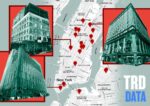Brandon Chasen saw big opportunities in Baltimore’s hollowed-out office buildings and jumped in head first, quickly becoming one of the city’s biggest office-to-resi converters.
But now he’s facing at least 18 lawsuits, creditors are going after his Ferraris and Gulfstream jet and his biggest project — converting Baltimore’s first high-rise office — has gone bust.
“He was trying to do four or five all at one time, without ever having done one this size,” said David Bowman, the receiver appointed to oversee One Calvert Plaza, which Chasen had planned to convert into 157 apartments.
Chasen Companies defaulted on the project’s $34 million loan last year, and his lender moved to take over the Beaux-Arts building. Earlier this month, the receiver hired brokerage NAI Michael to find a buyer in a foreclosure sale.
“This job is way over cost. And the pro forma is way above what could realistically be obtained when it’s finalized and starts to be leased up,” Bowman added.
One Calvert Plaza is just one example of the conversion projects faltering since developers rushed in to transform office buildings that had been emptied out by the pandemic.
While it’s true that developers in cities from New York to San Francisco are successfully moving forward with conversion projects, these failed redevelopments highlight the unique difficulties that come with transforming underused office buildings into apartments.
Developers must first buy a building at a low enough price — and then have to navigate challenges like relocating tenants that still have leases in place and dealing with unexpected costs. Rising interest rates make things even more difficult.
In sum, a project that looks good on paper can soon get out of hand.
In San Francisco, for example, the historic Warfield Building was set to be the city’s first conversion when developer Group I filed plans in 2022 to turn the building into 34 apartments.
But the company defaulted on its $26 million mortgage, and in February sold the building for $7 million to the local NPR-member radio station KALW Public Media, which will use it as a hub for media, journalism and literature.
In Washington, Post Brothers was hit with a foreclosure notice earlier this month after defaulting on a $78 million loan backing the 300,000-square-foot office building at 2100 M Street NW in the city’s West End. Philadelphia-based Post Brothers bought the building for $67 million in 2023 — a nearly 30 percent discount to the $92.5 million sellers Network Realty Partners and Meadow Partners paid in 2019 — and planned to convert the building into 400 apartment units.
Post Brothers president Matt Pestronk told Commercial Observer the developer was working on “resolving this matter and pursuing development of the property.”
And in Chicago, Chase Chavin’s Intersection last year handed the keys of the 24-story office at 65 East Wacker Place to lender Acres Capital. Intersection had purchased the building for $19 million in 2022 after the previous owner defaulted on its Acres mortgage and planned to convert a portion of the 96-year-old building into 144 apartments.
It was one of the earlier projects in Chicago hoping to pull off a successful conversion. But it had its issues: Although the building was half empty, there were 23 tenants that Chavin had to relocate. In the meantime, interest rates rose and some $300,000 in liens piled up at the project.
Acres has picked a new partner, Mavrek Development, and the two are moving forward with the project.
Pro forma
Successfully converting an office building is just the first step. Then there’s leasing and operating it.
In New York, Nathan Berman’s Metro Loft Management recently ran into debt troubles on two buildings it had converted in previous years.
Metro Loft — the city’s most prolific converter — failed to pay off a $265 million loan at 180 Water Street and a $250 million mortgage on 20 Broad Street when they matured last year. The company finished the conversion of the 573-unit 180 Water in 2017 and the 533-unit 20 Broad Street the following year.
Both buildings are nearly fully occupied, though they continue to offer incentives to renters. One of the notorious features of a converted office building is that they sometimes create awkward apartments with inconvenient layouts and poor light and air.
Berman, however, said the troubles had nothing to do with the fact that they were conversions, but simply that they were overleveraged.
“They’re both at 99 percent occupancy and at the highest numbers they’ve ever produced. In that regard, they’re doing as well as we could’ve possibly expected them to do,” he said. “The level of leverage we put on them worked fine at lower rates. It’s not like all of a sudden these buildings simply no longer work.”
Metro Loft sold 20 Broad to its lender in January, and Berman said he’s bringing in a partner at 180 Water Street and the two will pay off the building’s mezzanine debt.
There’s still a question, though, of how so many conversion projects will impact the market.
One of the problems Chasen had in Baltimore, Bowman said, was that more units started coming online than the market could comfortably absorb. In Manhattan’s Financial District, there are at least four conversions in the pipeline with roughly 3,800 units planned, and it remains to be seen how well they will rent and at what numbers.
Christopher Albanese of the Albanese Organization said at a panel discussion over the summer that he thinks some of them will struggle to hit the rents they need to pencil out.
“People are throwing around $100 a foot,” he said. “Yes, rents are $100 a foot, but not when your apartment is looking into a brick wall and it’s a 700-square-foot studio with one small window.”
Read more



